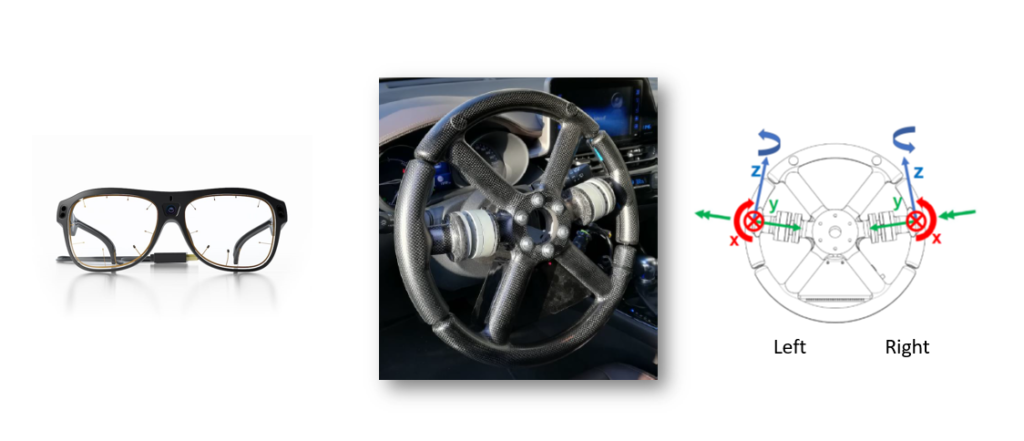The dynamic driving simulator installed in the DriSMi laboratory is a new generation, medium-sized simulator with a structure comprising six electric actuators (hexalift) that can move the driver’s compartment in six ways (movements along the x, y and z axis, yaw rotation, pitch and roll) with a bandwidth of about 20Hz. The hexalift system is mounted on three pneumatic pads for moving the driver’s compartment on a plane without friction. The thickness of the air film is controlled by electromagnets. Movement of the driver’s compartment using the pneumatic pads takes place with three degrees of freedom.
The longitudinal and lateral movement on a platform of 6×6 metres on the platform involves the pulling of four ropes, controlled by four independent electric motors that guarantee the decoupling of the lateral and longitudinal displacements and the yaw rotation. Movement in both directions and yaw rotation can be up to and over 60°, with a bandwidth of ~3Hz.
This architecture with increased workspaces guarantees greater possible accelerations than similar simulators: up to 1.5g in the longitudinal and lateral direction, and up to 2.5g in the vertical direction. The total latency of the system is estimated at about 20ms, an excellent value considering the wide range of movement allowed. There is also a system consisting of three sliding masses to compensate for the inertia of all the masses involved and to prevent significant dynamic loads from reaching the guide cables.
In addition to the 5 projectors and the 270° screen, a seat with active cushions and tension belts are also used to improve the driver’s immersiveness during the test. These systems allow long lateral and longitudinal accelerations to be felt. An electric motor allows the driver to reverse the steering to obtain a realistic torque at the wheel and simulate active power steering control systems. There is also an active hydraulic brake system, which allows the driver to get the desired feeling on the brake pedal and to perceive the effects of active controls, such as ABS. Finally, a system of five speakers reproduce the sources of noise in and out of the vehicle while driving.
For the purpose of studying comfort, there are 8 shakers on board with a bandwidth of up to 200Hz to reproduce the vibrations that come from the engine and road irregularities.
There is an instrumented steering wheel able to measure the forces and moments exerted by the driver, an eye-tracking system for studying the driver’s behaviour while driving, and a bio-telemetry system that measures the electrocardiogram and the skin potential resistance (SPR) during driving. Lastly, there is a cap for the electroencephalogram of the driver during manoeuvres.
Technical Specifications
| Longitudinal | Lateral | Vertical | Yaw | Roll | Pitch | |
| Displacement | 4.2 [m] | 4.2 [m] | ±0.298 [m] | ±62 [deg] | ± 15 [deg] | ± 15 [deg] |
| Acceleration | 1.5 [g] | 1.5 [g] | 2.5 [g] | – | – | – |
| Frequency | ≈ 3 [Hz] (Diskframe) ≈ 30 [Hz] (Hexalift) | ≈ 3 [Hz] (Diskframe) ≈ 30 [Hz] (Hexalift) | – ≈ 30 [Hz] (Hexalift) | ≈ 3 [Hz] (Diskframe) ≈ 30 [Hz] (Hexalift) | – ≈ 30 [Hz] (Hexalift) | – ≈ 30 [Hz] (Hexalift) |
- Overall latency ≈ 20 ms
- Inertial Compensation System
- 5 projectors for a realistic 270° driving scenario
- Customizable driving and traffic scenarios
- 14 Dof vehicle real-time model
- Motion Cueing
- Active seat & belts to mimic sustained accelerations
- Active steering for a realistic feedback and active steering control system
- Active brake and throttle pedals for a realistic feeling
- 5 speakers as internal and external noise sources
- 8 on-board shakers (bandwidth ≈ 200 Hz) as noise/vibration sources for NVH studies
- Interchangeable cockpit
- Instrumented steering wheel to measure the force applied by each hand
- Eye tracking glasses
- Electroencephalogram
- Electrocardiogram
- Skin conductivity
- Hardware & Software in the loop
